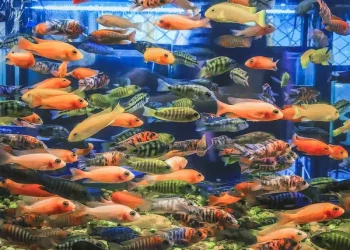Lungfish are an ancient group of fish that have evolved unique ways of breathing, making them one of the most fascinating species in the aquatic world. They have been around for over 380 million years and are found in various parts of the world, from Africa to South America and Australia. One of the most intriguing aspects of lungfish is their ability to breathe in both water and air. In this article, we’ll explore how lungfish breathe and the adaptations that allow them to survive in different environments.
- Water Breathing
Like most fish, lungfish primarily breathe through gills when they are in the water. Gills are specialized organs that extract oxygen from the water as it passes over the gill filaments. The oxygen is then diffused into the bloodstream and transported to the rest of the body. Lungfish have a unique set of gills that are adapted for their lifestyle. They have longer and more complex gill filaments than other fish, which helps to increase their surface area and improve oxygen uptake.
One of the interesting things about lungfish is that they are capable of surviving in environments with very low oxygen levels. They can do this by using their swim bladder as a supplementary respiratory organ. The swim bladder is an air-filled sac that helps fish to maintain buoyancy. In lungfish, the swim bladder has evolved to have a dual function. It can extract oxygen from the water and transport it to the bloodstream, allowing the fish to survive in oxygen-poor environments.
- Air Breathing
Lungfish are also unique in their ability to breathe air. In fact, they are one of the few species of fish that can do this. Lungfish have a specialized lung-like organ that allows them to extract oxygen from the air. This organ is known as the “lung,” and it is used primarily when the fish is out of the water. When lungfish come to the surface to breathe, they gulp air into their lungs and then use the oxygen in the air to supplement their gill respiration.
The lung of the lungfish is different from the lungs of other animals, such as mammals. The lung of the lungfish is a single large chamber, whereas the lungs of mammals are divided into smaller compartments. This single-chambered lung is better adapted for the aquatic environment in which lungfish live, as it allows them to quickly and efficiently extract oxygen from the air when they come to the surface.
- Adaptations for Survival
Lungfish have evolved several adaptations that allow them to survive in different environments. Their ability to breathe in both water and air is just one of these adaptations. Another adaptation is their ability to aestivate, which is a type of dormancy similar to hibernation. Lungfish can bury themselves in mud and enter a state of suspended animation when their aquatic environment becomes too dry. This allows them to survive until the environment becomes more suitable for their lifestyle.
Lungfish are one of the most fascinating species in the aquatic world. Their ability to breathe in both water and air is a testament to the incredible adaptations that have allowed them to survive for over 380 million years. By using their specialized gills and lungs, lungfish are able to extract oxygen from both water and air, making them well-suited to their aquatic lifestyle. As we continue to learn more about these amazing creatures, we may discover even more fascinating adaptations that have allowed them to survive for so long.


























